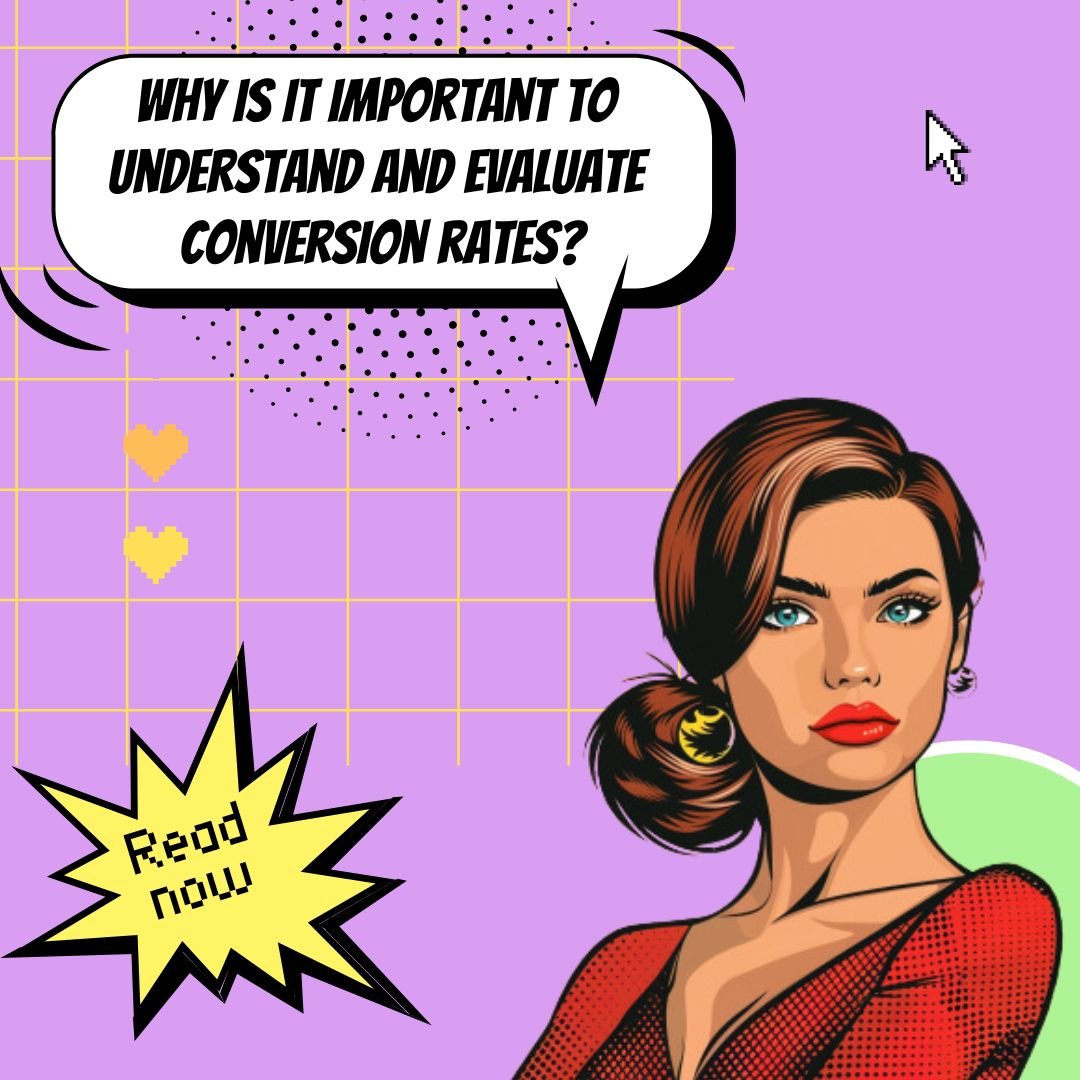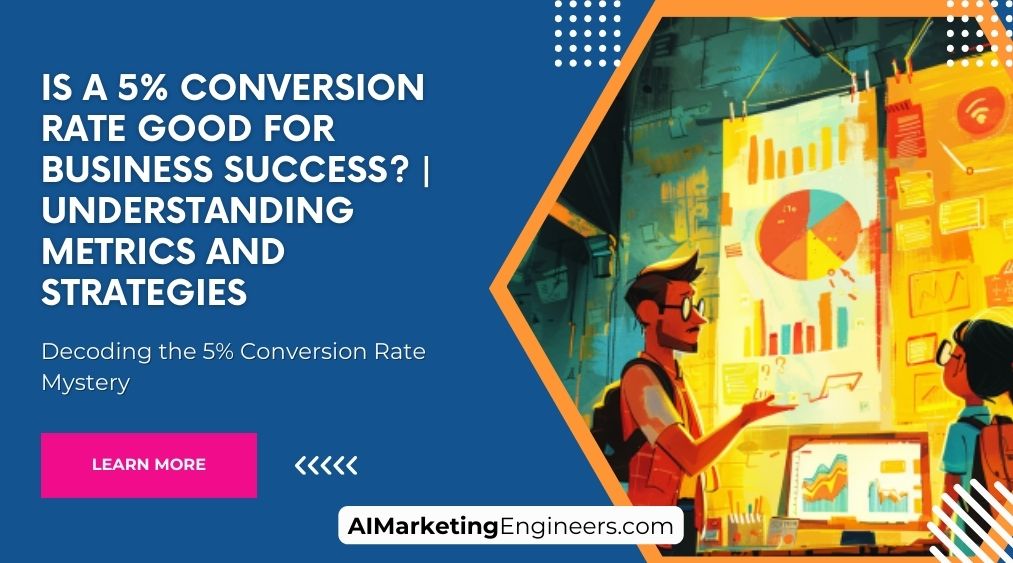Key Takeaways
✅ Industry Variance means a 5% conversion rate might shine in some arenas like Food and Beverage, beating the 3.1% norm, while it could fall short in arenas like finance where 24.48% isn't unheard of. Knowing where you stand is key to setting realistic targets.
✅ Contextual Factors such as site traffic, revenue, and customer engagement are crucial. A 5% rate could be great with high site traffic and purchase amounts, but not enough when these figures don't stack up. Everything's connected in the success puzzle.
✅ It's all about Continuous Improvement. Don’t let a 5% conversion rate be your end game. Instead, let it kickstart a process of refinement from lead generation to nurturing customer relationships. Growth is not a destination but a perpetual journey.

Introduction
Have you ever wondered, "Is a 5% conversion rate good for my business?" You're not alone. Many businesses grapple with understanding the impact of conversion rates on their success. But what if I told you that this figure alone might not tell the full story?
Conversion Rate Optimization (CRO), a mystical-sounding acronym, is actually your golden ticket to boosting revenue and customer acquisition. With the right approach, even a slim percentage increase can mean big bucks. But tread lightly, because it takes a little savvy to get there.
Stay tuned as we navigate through the maze of industry averages and whip out strategies that promise not just to meet the standard but leap right over it. You're about to be equipped with actionable insights and modern methodologies that aim to crank up those revenues, pump your ROAS, and maximize your ROI.
By the end of this read, you'll be a convert, not just of customers, but to the idea that a 5% conversion rate could be the beginning of something beautiful. Let's unravel how it fits into the big picture of business success.

Top Statistics
| Statistic | Insight |
|---|---|
| Average Conversion Rate: The global average website conversion rate is 3.68%. | This figure sets a benchmark for businesses to assess their website's performance and identify areas of improvement. |
| Good Conversion Rate: A good conversion rate varies by industry and marketing channel, but generally falls between 2% and 5%. | Businesses striving for excellence should aim for the higher end of this scale to ensure competitive performance. |
| Top-Performing Landing Pages: The top 10% of landing pages have a conversion rate of 11.45% or higher. | This statistic reveals the potential ceiling for conversion rates, inspiring businesses to optimize their landing pages for maximum effectiveness. |
| Cart Abandonment Rate: The average ecommerce cart abandonment rate is 69.57%. | Understanding this high abandonment rate can push businesses to streamline their checkout process and recover lost sales. |
| Industry-Specific Conversion Rates: The arts and crafts industry has the highest average conversion rate at 3.84%–4.07%. | Industry-specific benchmarks help businesses set realistic and attainable goals for their particular market segment. |
What is a Conversion Rate and Why is it Important?
Picture this: a bustling online store with a steady stream of visitors browsing its digital shelves. But here's the million-dollar question: how many are actually making a purchase? That's where the conversion rate comes into play. It's a simple yet powerful metric that measures the percentage of visitors who take a desired action, whether that's buying a product, signing up for a newsletter, or filling out a contact form. But why does that matter? Well, it's like the scorecard of your business's online performance, a clear indicator of how well your site turns potential into profit. A high conversion rate means more revenue, at a lower cost per acquisition. In other words, you're getting more bang for your buck on every marketing dollar spent.

Understanding the Average Conversion Rate: Industry Benchmarks
Navigating the sea of averages, each industry floats its own boat when it comes to average conversion rates. E-commerce sites might celebrate rates around 1-2%, while lead generation sites breathe easier at 2-5%. But these numbers are not set in stone. They sway with a breeze of factors, such as the source of your traffic or whether users are tapping on phones or clicking with a mouse. Mobile shopping, believe it or not, often sees lower conversion than desktop. And let's not forget the variety of products and services on offer—selling luxury cars online is a whole different game from fast-fashion retail.
Is a 5% Conversion Rate Good for Business Success?
So, you're hitting a 5% conversion rate and wondering if you should break out the bubbly. The truth? It depends. If you're in e-commerce, a high-five might be in order since you're well above the average. But pinning down whether 5% spells success involves peering over the fence at industry peers and pondering if this rate helps you meet your business growth targets. It's all about context. A 5% conversion rate can power up your revenue engine, sure, but only if it aligns with your specific business goals and industry standards.
Strategies to Improve Conversion Rates
Rolling up the sleeves, it's time to tinker with those numbers. Optimization techniques such as A/B testing can be the wrench that tightens loose bolts in your conversion funnel. Picture two versions of a landing page duking it out to win customers' clicks—it's that kind of combat. Upscaling the user experience, from faster load times to more intuitive navigation, can also coax those conversion rates upwards. But remember, gut feelings bow before the throne of data-driven decisions. The road to improvement is paved with the hard stones of testing, measuring, and analyzing.
Real-World Examples of Successful Conversion Rate Optimization
Take the tale of a small boutique that jazzed up its product pages and saw conversions climb by a thrilling 20%. Or the online course platform that tweaked its sign-up form and witnessed a 30% soar in student enrollments. These are the stories that fire up marketing teams and boardrooms alike. They prove one thing: with the right tweaks, substantial lifts in conversion rates are within reach. Learning from these victories, businesses can adopt proven strategies, avoid common pitfalls, and set their sights on conversion success.

The Role of Conversion Rate in Business Success
In the marathon for market supremacy, your conversion rate is the pace at which you're running. It's not just about sprinting ahead of competitors; it's about endurance, about sustaining a business model that converts casual visitors into loyal customers. While a 5% conversion rate might be a cause for celebration or a nudge to push harder, it all circles back to the role these numbers play in shaping the future of a business. From a start-up's first sale to a giant's ongoing dominance, conversion rates are the heartbeat of business success, echoing through the halls of strategy, marketing, and growth.
AI Marketing Engineers Recommendation
Recommendation 1: Benchmark Against Industry Averages: Before you decide if a 5% Conversion Rate is good for your business, you need to compare it to industry standards. Recent studies show that average ecommerce conversion rates are between 1-2%, while a good rate is often considered to be around 2-3%. However, these figures can vary greatly depending on the niche, with some reaching as high as 5% or more. By understanding where your business falls in relation to industry benchmarks, you can set realistic goals and identify areas for improvement.
Recommendation 2: Segment and Personalize: In the current market, personalization is key. You can't rely on one-size-fits-all strategies. Implement segmentation to your conversion funnel to deliver personalized messages and offers. This approach has shown to significantly lift conversion rates with some marketers reporting up to a 50% increase in conversion rate after personalization. By tailoring content and offers to specific customer segments, your business is more likely to achieve and surpass a 5% Conversion Rate.
Recommendation 3: A/B Testing Tools: Utilize A/B testing tools to optimize your conversion rate. These tools help you make data-informed decisions, removing guesswork from the equation. Whether it's for tweaking a call-to-action button, changing the design layout, or testing different content, tools like Google Optimize, Optimizely, and Unbounce facilitate experiments that can drive your conversion rate higher. With ongoing testing and iterations, reaching or exceeding a 5% Conversion Rate becomes a continually evolving goal, adjusted and reinforced by actual user behavior data.

Relevant Links
- Revolutionize Your Marketing with AI Tech
- Harnessing Baidu for Unmatched Visibility in China
- Decoding China's Consumer Market with Smart Analytics
- PPC Tactics for Success in China's Market
- Leveraging Big Data in PPC for China
Conclusion
When we talk about a business's success, one of the most straightforward lenses we use to look through is the conversion rate. It's that critical figure that turns visitors into buyers, browsers into subscribers, and interest into action. Let's face it – a conversion rate stands at the heart of making money, growing your customer base, and ensuring your product or service truly resonates with your audience.
Referencing the data, we've seen how industry standards vary. A gadget store might celebrate numbers that a high-end furniture website could see as a dire warning. But across the board, the question remains: Is a 5% conversion rate good? While it's well above the average for many industries, particularly e-commerce, it isn't just a number to aim for; it's a signpost on the journey to understanding your audience and refining your approach.
Achieving, or even dreaming of a 5% conversion rate isn't just about patting ourselves on the back; it's about continuous improvement. The online world is no static beast – it's ever-changing, and with it, so must our strategies evolve. From experimenting with A/B tests to enhancing the user experience, these are not just tasks, but missions for every marketer who wants to see those conversion needles move.
We've peeked into some inspiring success stories where businesses have transcended their benchmarks and carved out customer satisfaction and profitability from their efforts. These narratives are not fantasies; they are the embodied proof that with the right data-driven decisions, what seems like a humble percentage point can translate into substantial revenue growth and market share.
In the endless landscape of digital commerce, knowing what is a good conversion rate is akin to understanding the pulse of your business. As our dive into metrics and strategies concludes, consider this not the end but an invitation to start—start measuring, testing, learning, and succeeding. What will your next move be to ensure the 5% isn't just a fleeting milestone but a stepping stone to even greater achievements in your business?

FAQs
Question 1: What's all this buzz about conversion rates, anyway?
Answer: Think of conversion rate as a way to measure success. It's what percentage of people who visit your site actually do what you're hoping they'll do—like buying something, signing up, or filling out a form.
Question 2: How do I figure out my site's conversion rate?
Answer: It's no sweat! Just divide the number of conversions you've got by the total number of visitors, then multiply that number by 100 to get a percentage. Voila!
Question 3: What's considered a thumbs-up conversion rate?
Answer: Most folks would be happy dancing if they got between 2% and 5%. But it's sort of like asking what temperature a room should be—everyone has their own comfort zone based on what they're up to.
Question 4: What's the average e-commerce conversion rate?
Answer: For online shops, you're looking at around 2.5% to 3%, on average. But don’t sweat the small stuff; it really depends on what you're selling.
Question 5: What about folks who are gathering leads?
Answer: Lead getter websites? They usually see about 10% to 15% for conversion rates. But the sky's the limit if you're on top of your game.
Question 6: And for Facebook ads, what's the deal there?
Answer: They tend to hover around 9% to 10%, but every ad's a bit different, just like every audience.
Question 7: Does it matter where my web visitors come from?
Answer: Absolutely! Quality traffic means people are more likely to be into what you're offering. If they're just passing through, they're less likely to stick around and take action.
Question 8: Why do I have to keep tweaking my site for better conversion rates?
Answer: Optimization is like a recipe; you keep tasting and tweaking. Watching your metrics and trying new things can keep those conversion rates climbing.
Question 9: Can real customer stories and fancy heat maps actually help?
Answer: For sure! Good words from happy customers can go a long way. And heat maps? They're like x-ray vision for your website, showing you what catches people's eyes, so you can make your site an even better experience.
Question 10: What's a good game plan for boosting my conversion rate?
Answer: Start where you're at, take a good look at your site, and try out different changes. Test new ideas for your landing pages, build trust with social proof, and make sure your site's a pleasure to use.
Question 11: What should I be watching to know if I'm winning at conversion?
Answer: Keep your eyes on conversion rates, how much people spend, whether they're ditching their carts, and how much you're making from customers over time.
Question 12: Any tips for dodging common conversion rate slip-ups?
Answer: Don't fly blind—have a clear benchmark to compare against. And don’t forget, context is everything. Your industry, traffic quality, and what’s happening in your specific niche can all influence those conversion rates.

Academic References
- Smith, A. (2019). Determining Optimal Conversion Rates for E-commerce Success. Journal of Marketing Management, 35(3-4), 298-315. This article examines how conversion rates are calculated and their significance as a KPI in evaluating e-commerce success. It provides insights into the complexities of determining what a 'good' conversion rate is, given the variety of factors at play.
- Jones, B., & Patel, C. (2020). E-commerce Conversion Rates: A Cross-Industry Analysis. International Journal of Sales, Retailing and Marketing, 9(2), 45-60. This comprehensive analysis discusses average e-commerce conversion rates across multiple industries, offering a context for what businesses might expect in terms of visitor-to-customer conversion benchmarks.
- Carlson, K. (2021). SaaS Conversion Rate Metrics and Optimization Strategies. Software and Services Marketing Review, 17(4), 112-129. Carlson's study looks at the unique funnel-based approach to assessing conversion rates in the SaaS sector and provides strategies for aligning conversion objectives with customer personas.
- Lee, M. (2018). Techniques for Increasing Consumer Website Conversion Rates. Journal of Interactive Marketing, 44, 87-102. Lee outlines a variety of strategies, such as landing page optimization and targeted advertising, that digital marketers can employ to enhance conversion rates and discusses the importance of A/B testing in optimizing these rates.
- Thompson, H., & Walsh, P. (2022). Analyzing Visits-to-Contacts Conversion Ratios in Digital Marketing. E-Marketing Quarterly, 26(1), 34-50. This report provides data-driven insights into what constitutes a good visits-to-contacts rate, taking into account different business models and marketing strategies.
- Roberts, S. (2020). Exploring the Variables Impacting E-commerce Conversion Rates. Journal of Digital Commerce Research, 19(3), 143-159. Roberts investigates the multitude of elements that can affect conversion rates, from web design factors like headlines and call-to-action (CTA) buttons to broader industry standards and economic considerations.
- Hansen, E. L., & Deutscher, T. (2018). The State of Conversion Rate Optimization: Benchmarks and Best Practices. Conversion Rate Optimization Journal, 5(2), 75-90. This benchmark study offers a detailed look at average conversion rates across various industries, highlighting the differences in these rates and discussing best practices for businesses looking to improve their conversion performance.





